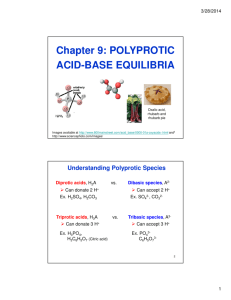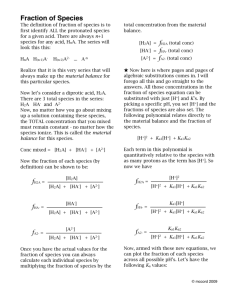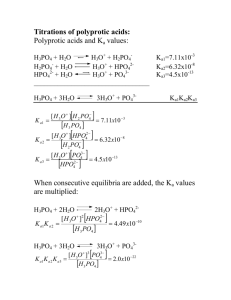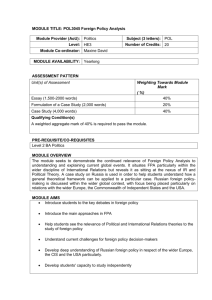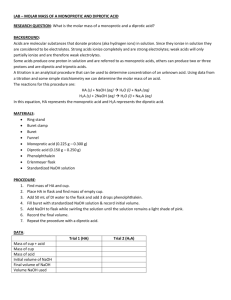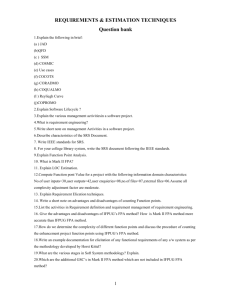Chapter 10
advertisement
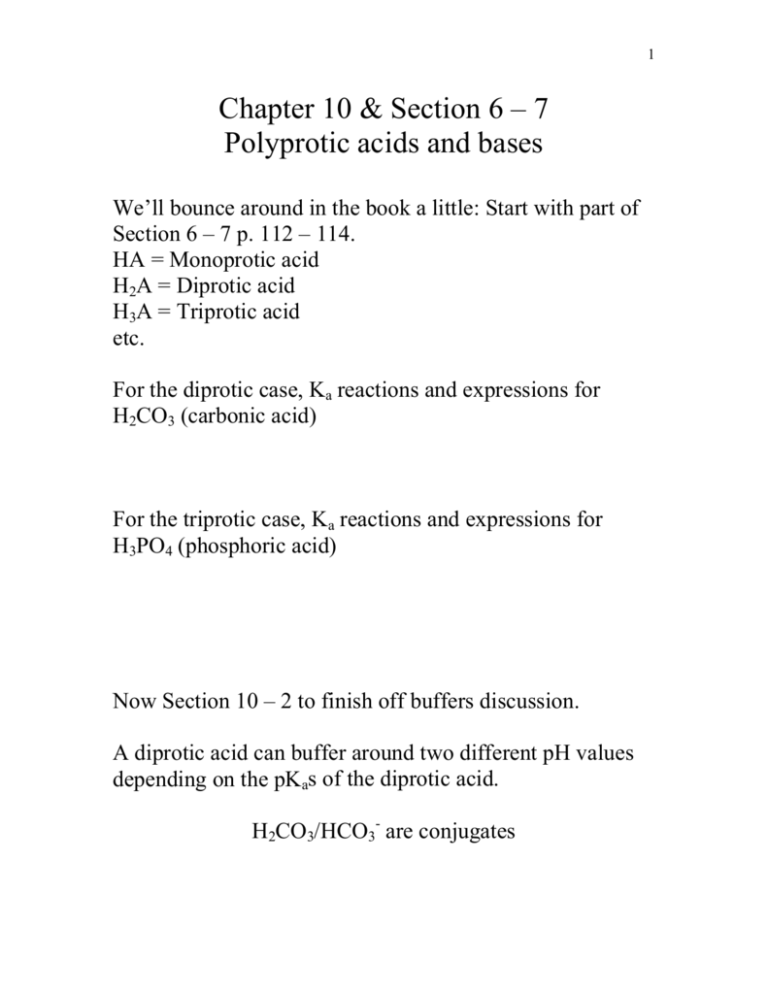
1 Chapter 10 & Section 6 – 7 Polyprotic acids and bases We’ll bounce around in the book a little: Start with part of Section 6 – 7 p. 112 – 114. HA = Monoprotic acid H2A = Diprotic acid H3A = Triprotic acid etc. For the diprotic case, Ka reactions and expressions for H2CO3 (carbonic acid) For the triprotic case, Ka reactions and expressions for H3PO4 (phosphoric acid) Now Section 10 – 2 to finish off buffers discussion. A diprotic acid can buffer around two different pH values depending on the pKas of the diprotic acid. H2CO3/HCO3- are conjugates 2 HCO3-/CO32- are conjugates A triprotic acid can buffer around three different pH values depending on the pKas of the triprotic acid. H3PO4/H2PO4- are conjugates H2PO4-/HPO42- are conjugates HPO42-/PO43- are conjugates A diprotic buffer example: How many mL of 0.8 M KOH should be added to 3.38 g of oxalic acid (90 mg/mmol, H2A) to give a pH of 4.4? pKa1 = 1.25 pKa2 = 4.27 The desired pH > pKa2 so need a mixture of HA-/A21. Add enough base to convert all H2A Æ HA2. Add more base to convert some HA- Æ A2- until pH = 4.4 3 To do the first part: To do the second part: 4 Now to finish Section 6 – 7 For a monoprotic acid Ka x Kb = Kw Similar relationships can be derived for polyprotic systems, a little more tricky. For a diprotic system: H2A, HA-, A2- may exist Most acidic = Ka1: Most basic = Kb1: HA- as acid = Ka2: HA- as base = Kb2: Now that these are defined, can do analogous derivations as the monoprotic system. 5 Triprotic system is now readily derived in the same way. For a triprotic system: H3A, H2A-, HA2-, A3- may exist. Ka1: Kb1: Ka2: Kb2: Ka3: Kb3: Putting these together: Tetraprotic, pentaprotic, hexaprotic, etc. – same process. Back to beginning of Chapter 10, Section 10 – 1. Find the pH of diprotic solutions, easily extended to polyprotic systems. Maleic acid is diprotic (H2A) – Harris uses the amino acid leucine starting on p. 181 for his example. The reactions, K expressions, and K values: There are 3 different calculations for this system. 1. Find the pH of a 0.05 M H2A solution. 2. Find the pH of a 0.05 M Na2A solution. 3. Find the pH of a 0.05 M NaHA solution. 6 The first 2 are not all that bad if everything works out. Number 1 – Find the pH of a 0.05 M H2A solution. Recognize that H2A is a weak acid - partially dissociates. HA- is weaker, and what little is present from H2A dissociation will dissociate even less. So to avoid having to solve an extremely unpleasant problem – hope H2A behaves like a monoprotic acid with Ka = Ka1. And also hope that [H+] from H2A >> [H+] from water. If both of these hopes come true, it reduces to a regular weak acid problem. Further hope that x << 0.05 so Certainly [H+] from H2A >> [H+] from water We have checked 2 assumptions, what about the third? Is the [H+] from H2A >> [H+] from HA-? (The monoprotic assumption) 7 For most polyprotic acids Ka1 >> Ka2. Bottom line: A solution of the fully acidic form of a polyprotic acid behaves like a solution of a monoprotic acid with Ka = Ka1. Number 2 – Find the pH of a 0.05 M Na2A solution. A2- is a weak base that partially hydrolyzes in water. HA- is a weaker base, and little should be in solution anyway. So to avoid solving a very unpleasant problem, hope A2behaves like a monobasic compound with Kb = Kb1. And – hope the [OH-] from A2- >> [OH-] from water. If both of these hopes come true – then you have a regular weak base problem. 8 For most polyprotic systems Kb1 >> Kb2 so Bottom line: A solution of the fully basic form of a polyprotic system behaves like a monobasic species with Kb = Kb1. Number 3 – Find the pH of a 0.05 M NaHA solution. NaHA Æ Na+ + HAHAH+ + A2Ka2 and HA- + H2O H2A + OHKb2 This is trouble, HA- is amphiprotic Ignore Kb2 since it is much less than Ka2? No can do, these equilibria are coupled. + H from Ka2 + OH- from Kb2 Æ H2O driving Kb2 reaction to the right, more important than the Kb2 value suggests. Bite the bullet – set up using systematic approach. Will simplify later, so don’t get lost in the forest. 9 Species in solution: H+, OH-, H2A, HA-, A2-, Na+ 5 species in solution, need 5 equations to solve: 1. Ka2 = 2. Kb2 = 3. Kw = 4. Charge balance: 5. Mass balance: Go through lots of algebra, many substitutions [H+] = Don’t know the [HA-], but Ka2 and Kb2 are very small so the simplifying process begins: hope [HA-] = F = 0.05 M in this problem. [H+] = Put in values for all => pH = 4.17 Always check to see if hope came true, find [H2A], [A2-] 10 It is worth noting that [A2-] ≈ [H2A] even though Ka2 >> Kb2. These reactions are coupled! In any case the concentrations of these 2 species are small, relative to 0.05 (F) anyway, so our hope did come true. Continuing to simplify the equation used above to calculate pH: usually Ka1Kw << Ka1Ka2F so the equation simplifies to [H+] = One more simplification. Often Ka1 << F so Take –log of both sides: Bottom Line: the pH of an amphiprotic (intermediate) species is the average of the pKas. Diprotic summary: 1) H2A: Treat as monoprotic with Ka = Ka1 2) A2-: Treat as monobasic with Kb = Kb1 3) HA-: Take the average of the pKas This is readily extended to triprotic systems and beyond (Section 10 – 3). 1) H3A: Treat as monoprotic with Ka = Ka1 2) H2A-: Treat as amphiprotic with pH = 11 3) HA2-: Treat as amphiprotic with pH = 4) A3-: Treat as monobasic with Kb = Kb1. Section 10 – 4 Principal species First monoprotic, then polyprotic A.Monoprotic. The question is, at a given pH what is the majority species? For an acid/conjugate base system is it HA or A-? For a base/conjugate acid system is it B or BH+? In either case this is most easily treated using the buffer equation which, recall, is just the rearranged form of the Ka expression. Take benzoic acid as an example, with a pKa = 4.2. 1. At pH = 4.2: 2. At pH = 5.2 3. At pH = 3.2 12 When the pH < pKa the acidic form is in the majority (i.e. the principal species. When the pH > pKa the basic form is the principal species. B. Polyprotic systems. What is the predominant species at any given pH? Similar reasoning but >1 pKa. For phosphoric acid, H3A 13 Section 10-6. Isoelectric and Isoionic pH Take alanine as an example: The isoionic point is the pH obtained when the pure, neutral intermediate species (the zwitterion) is dissolved in water. Here the [H2A+] ≠ [A-] (but very close) since intermediate species do not dissociate much (bottom p. 184). The isoelectric point is the pH at which [H2A+] = [A-]; where the average charge of the amino acid is zero. 14 The isoelectric point is important for the separation of proteins by electrophoresis using the clever technique of isoelectric focusing (Box 10-2, p. 194). Chapter 10 Exercises A, B, C Problems 1, 4, 5, 11-13, 15, 17, 18a, 22, 23 In Chapter 10, those exercises in red and underlined are test 2 material. Remainder are for test 3. All remaining exercises and problems in Chapters 8 and 6 are for test 2, but material associated with Chapter 10. Chapter 8 Exercises F, G, H Problems 15, 17, 18, 22 Chapter 6 Exercise I Problems 50, 51

